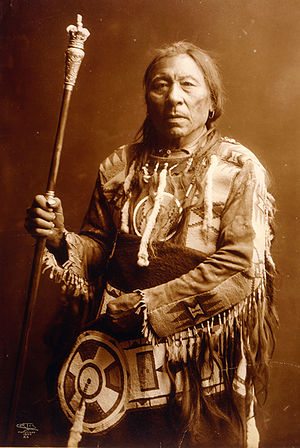
Aatsista-Mahkan
Encyclopedia

Circa
Circa , usually abbreviated c. or ca. , means "approximately" in the English language, usually referring to a date...
1833 – probably 24 January 1911) was a chief
Tribal chief
A tribal chief is the leader of a tribal society or chiefdom. Tribal societies with social stratification under a single leader emerged in the Neolithic period out of earlier tribal structures with little stratification, and they remained prevalent throughout the Iron Age.In the case of ...
of the Siksika
Siksika Nation
The Siksika Nation is a First Nation in southern Alberta, Canada. The name Siksiká comes from the Blackfoot words sik and iká , with a connector s between the two words. The plural form of Siksiká is Siksikáwa...
First Nation. He was the son of Akamukai (Many Swans), chief of the Biters band, and following the death of his father in 1871, Aatsista-Mahkan took control of the band. He was known for his generosity and kindness, and for his loyal protection of his family.
In 1877, he was a signatory to Treaty 7
Treaty 7
Treaty 7 was an agreement between Queen Victoria and several mainly Blackfoot First Nations tribes in what is today the southern portion of Alberta. It was concluded on September 22, 1877. The agreement was signed at the Blackfoot Crossing of the Bow River, at the present-day Siksika Nation...
, but he and his people continued to follow the bison
Bison
Members of the genus Bison are large, even-toed ungulates within the subfamily Bovinae. Two extant and four extinct species are recognized...
until 1881, when he and his people were forced to settle on a reserve
Indian reserve
In Canada, an Indian reserve is specified by the Indian Act as a "tract of land, the legal title to which is vested in Her Majesty, that has been set apart by Her Majesty for the use and benefit of a band." The Act also specifies that land reserved for the use and benefit of a band which is not...
, 60 miles east of today's Calgary
Calgary
Calgary is a city in the Province of Alberta, Canada. It is located in the south of the province, in an area of foothills and prairie, approximately east of the front ranges of the Canadian Rockies...
, Alberta
Alberta
Alberta is a province of Canada. It had an estimated population of 3.7 million in 2010 making it the most populous of Canada's three prairie provinces...
.

